Abstract
Extending set-point temperatures in residential buildings has a significant impact on energy demand and thermal comfort. European governments have adopted this strategy to mitigate the energy crisis. Previous studies attempting to quantify energy savings by extending set-point temperatures were limited due to a lack of building stock characterisation, poor climate representation, and the absence of uniformity in the reference set-point temperature. In this study, a large-scale simulation was conducted, which included six building models covering 90% of southern Europe Köppen–Geiger climates, where 20 °C and 25 °C were the reference heating and cooling set-point temperatures, respectively. This also accounted for the thermal characteristics of the older building stock, built more than 15 years ago, and the new buildings built under the latest version of Directive 2010/31/EU. The results show that reducing the heating set-point temperature by 1 °C can lead to an average demand reduction of 20%, while raising the cooling set-point temperature by 1 °C can lead to a 25% cooling demand reduction. The oldest building stock shows a higher absolute savings potential. Adjusting thermostats by 1 °C in Spanish homes during the winter season could represent a saved natural gas volume of 1.8 million normal cubic meters, nearly 40% of the gas demand of households in 2022. These findings suggest that extending the set-point temperatures in residential buildings can be a promising strategy towards a more energy-efficient society without compromising the occupant’s thermal comfort.
1. Introduction
On 20 February 2022, Europe awoke with Russia declaring war against Ukraine. This conflict is promoting energy cost volatility along with energy insecurity, with particular effects on the European energy market, especially on the cost and availability of gas. In 2021, Russia accounted for more than 40% of the EU gas supply [1]. Since the conflict broke out, Russia has been reducing its gas supplies to the EU as an answer to the economic and political sanctions imposed by the European Commission and Council. As a result, in July 2022, the European Commission proposed a gas demand reduction plan, which asks all Member States to reduce their dependence on gas by 15% [1]. The main goal of this reduction plan is to ensure the gas supply to the essential economic activities and families during the transition to other suppliers.
The European Commission suggests a wide range of measures that the Member States can adopt: increasing and promoting the integration of renewable power; fuel switching in industries and power plants; introducing demand-side flexibility in the electricity sector; and promoting the reduction of heating and cooling demand [2]. The urge to save gas for having a “safe” winter is highlighted by recent news about the operation struggles of Nord Stream 1 and the significant decrease in supplied gas from Russia to Europe [3]. Since April 2022, the European Commission has been asking everyone to start saving energy, especially gas and electricity, by adopting a more conscious behaviour. It is expected for the European residential building stock that adjusting our thermostats by 1 °C can lead to a reduction of 7% and 10% in heating and cooling demand, respectively, where the heating savings potential could lead to a natural gas reduction of 10 thousand million cubic meters, according to an International Energy Agency report for the European Commission [4,5].
An energy crisis requires a society that is more conscious and less energy-demanding. In the 1970s, due to the oil crisis, one of the immediate actions adopted by the Danish Government was to ask householders to reduce their heating energy demand by lowering the temperature set-point along with implementing building insulation improvements [6]. Similar actions were adopted by the US Government by setting up a National Energy Program to promote energy efficiency and new energy resources [7]. President Richard Nixon, in November 1973, addressed the citizens sharing their concerns about the scarcity of energy during the winter season. His speech underlined the urge for householders to reduce their thermostats by at least 3.8 °C and achieve an average indoor temperature of 18.9 to 20.0 °C [8]. In the following US Government, led by President Jimmy Carter, in January 1977, the saving energy measures were intensified as a result of the intense winter and the high pressure on the electricity utilities as well as on the gas suppliers [9]. All citizens were called to reduce their thermostats to 18.3 °C during daytime and set a lower value for night-time [9], in addition to rationing their electricity demand.
Changing consumer habits voluntarily is challenging, but not impossible. The response of householders to the electricity rationing program in Brazil from 2001–2002 provides clear evidence that consumers, if properly informed and motivated, can voluntarily contribute to reducing the electricity demand and acquire conscious behaviour [10]. More recently, in March 2011, due to the nuclear accident, the Japanese Government set a restriction on electricity use to reduce the pressure on the electric power system. Even though this restriction was applied only to large consumers and commercial sectors, many households implemented electricity-saving measures as a result of the electricity shortage and increasing costs [11]. Of the top ten adopted measures, the restriction actions of thermal comfort were in the lead. This restriction included reducing the time-use of heating and cooling systems and extending the set-point temperature of conditioning equipment.
Extending the set-point temperature has a relevant impact on energy demand as well as on the thermal comfort of the occupants. But how much we can save in a service building—or in our homes—by extending the set-point temperature? It depends on the building type, climate, and the considered set-point temperature. Based on the literature, it is difficult to specify a number or range of potential savings because of the diversity of set-point temperature ranges considered by the authors (Table 1). Nevertheless, the studies reveal that effectively increasing the cooling set-point temperature or decreasing the heating set-point temperature can lead to lower energy demand.

Table 1.
Summary of studies on the impact of extending set-point temperature on conditioned buildings.
On the other hand, the occupant’s thermal comfort may be affected depending on how far we go with changes to the thermostat. For cooling in office buildings, small changes in the room temperature are not perceived by the occupant [16], and if they are encouraged, they prefer a low comfort level [21]. However, increasing the room temperature above 27 °C reduces the thermal acceptance below 80% [20]. Conversely, in residential buildings during the winter season, reducing the room temperature to 18 °C diminishes the thermal acceptance by the occupants by 70% [33]. Nevertheless, the high acceptability for a such low temperature can be conditioned by the economic constraints of the householders, the quality of the indoor environment, and the clothing adaptability of the occupants [33]. The definition of the temperature set-point is challenging; on one side we can have higher savings, and on the other side, we can have unsatisfied users [24]. Assuming that the occupants can adapt to less favourable conditions, some authors explored the impact of using an adaptative set-point temperature on residential buildings, where the savings can be very expressive in some cases [23,26,27,29,31,32]. However, introducing the adaptive comfort model ([30] or [34]) in conditioned buildings can induce unreasonable situations; for example, during a heat wave, it is not expected that the occupants will tolerate temperatures near 32 °C or, during winter, temperatures near 17 °C if they have an air conditioning system.
Although office and commercial buildings have a relevant savings potential, as shown by various authors [12,14,15,17,18,19], these types of buildings cannot be generalised easily and represent only 17.4% of all building stock in the EU and 10.3% in the peninsular region of Spain [35]. The works that focused on the residential sector had a limited representation of the building stock or the climate. The majority explored multifamily buildings either as a whole [23] or as parts [26,29,31]. The impact on single-family buildings is addressed by Moon et al. [13] for two climate zones in the USA, and a study by Bienvenido-Huertas et al. [31] covered all European southern climates, while the remaining Spanish works considered only three climate zones.
This work studies the extension of the set-point temperature in Spain for a sample of six buildings that are representative of the Spanish building stock: three single-family buildings and three multifamily buildings [36,37]. This will allow a comprehensive analysis of the impact of geometry and urban constraints on the savings potential. There are considered two periods of building regulation—the first [38] and the latest implemented [39]—to assess the possible range of potential savings and the relevance of the thermal envelope. This detailed study will overcome the poor building stock characterisation, the climate representation, and the lack of uniformity of chosen set-point temperature. The novelty of this work is that it covers 90% of the southern European climates and enables a comparison of this strategy across different climates using a static set-point temperature approach. It considers a sample of six representative buildings from the Spanish residential stock, accounting for the impact of building geometry. The results of this study will serve as a reliable source of information for regulatory authorities in their decision-making process, particularly in defining suitable temperature set-points for each building typology, construction year, and climate zone. Furthermore, the study quantifies the expected impact on natural gas demand by introducing this strategy in Spanish homes.
2. Methods
Quantifying the potential savings for extending the set-point temperature can be complex, especially by the necessity of various simulations. To reduce the complexity of the simulation process, previous works for residential buildings have focused their studies on one building model and typology and a few locations [13,26,27,29,31] or on one building typology [23,32].
This work, using a different approach, considered six geometries (three multifamily buildings and three single-family buildings), five thermal envelopes, and two construction years, resulting in a total of sixty building models. In addition, full coverage of all nine Köppen–Geiger climates of the Spanish peninsular region was guaranteed by considering a typical meteorological year (TMY) for each municipality, 8034 in total. For the heating and cooling, four and six values, respectively, for the static set-point temperature were considered. Combining all the variables, we obtained a total of 96,408 cases to simulate. To perform this massive simulation, we developed a VBA Excel® script that was able to generate an IDF file according to the building model and their location, run a simulation on EnergyPlus for each temperature set-point, and save the results. Figure 1 schematises the simulation procedure considered.
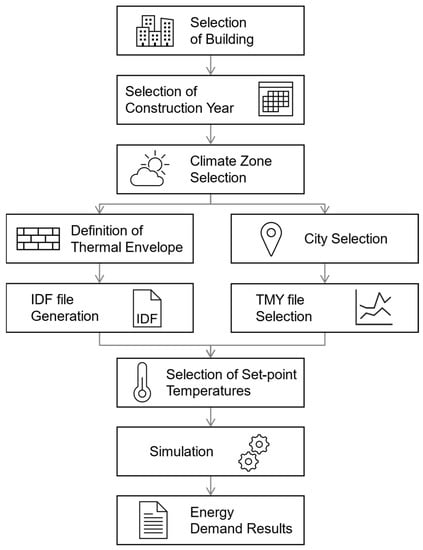
Figure 1.
Scheme of the energy demand calculation procedure.
An ideal load model of EnergyPlus was used to determine the heating and cooling load. This model simulates an ideal system to supply conditioned air to the zone that meets all the load requirements. However, to determine the final energy, we considered the HVAC template models of EnergyPlus for the typical heating and cooling technologies of Spanish homes, which included a gas boiler (η = 0.92), an electric radiator (η = 1.00) and an air-conditioner (split unit, COP = 2.90), according to Building Technical Code Standard DB-HE0 [40] and the housing characteristics survey [41].
The occupancy profile was defined according to Ahmed et al. [42]. Also considered were the suggested appliances and lighting usage profiles for residential buildings [42]. Regarding the last household survey in Spain [43], a nominal occupancy of 3 persons was assumed for each dwelling. The ideal load model considered the minimum outdoor airflow to ensure indoor air quality, which corresponded to 0.15 L/s·m2 of floor area and 3.5 L/s∙person [44], where no natural ventilative cooling strategy was considered.
In Section 2.1, the considered set-point temperatures for heating and cooling are presented. The generation of the TMY data and the exploration of climates are discussed in Section 2.2. Furthermore, Section 2.3 provides a summary of the building models utilized in the study.
2.1. Set-Point Temperature
The reference indoor range temperature was defined as 20–25 °C, which corresponds to the definition of room temperature [45] and to the neutral comfort range indicated by ASHRAE [44] and the Spanish Building Technical Code [39]. The minimum heating set-point considered was defined as 17 °C, considering that the allowed lower limit for the operative temperature by ASHRAE 55-2020 Standard [34] corresponds to the average indoor air temperature. The maximum cooling set-point considered was defined as 30 °C. The two models of adaptive comfort [30,34] suggested a value of 31.7 °C as the maximum acceptable operative indoor condition. According to the authors, a value above 29 °C for indoor air temperature was too high in conditioned spaces. The value of 30 °C was studied to verify whether extreme indoor conditions had comparable savings potential to the remaining cooling set-points temperature. Table 2 presents the studied set-point temperatures.

Table 2.
Set-point temperatures (°C) for heating and cooling systems.
A static set-point temperature was preferred since the adaptative model, at first, did not allow a quantification of the energy demand per each increment in the dead band; secondly, it assumed that all the thermostats could run a dynamic set-point or that the occupants were available to change their set-point temperature, at least on a daily basis.
The intent of implementing a chosen set-point temperature is to overcome the lack of uniformity in defining a temperature set-point, as identified in the previous section and in a recent building operator’s survey [46].
2.2. Climate
Southern and central Europe are characterised by a mostly warm temperate (C) and continental (D) climate [47]. According to the Spanish Meteorological Agency (ANMET) [48], in the peninsula, 77.4% of the territory is characterised by a warm temperate climate (60.2% for Cs and 17.4% for Cf) and 21.6% by a dry climate (21.3% for BS and 0.3% for BW). Only 0.8% of Spain’s peninsular region is characterised by a continental climate (0.3% for Ds and 0.5% for Df). Ninety percent of southern European climates are present in Spain’s peninsular region [47,48].
The climate zones considered in this study are summarised in Table 3. This table presents an overlapping of the Köppen–Geiger climate classification for Spain’s peninsular region [48] with the climate classification defined by the building code [39,49]. For the application of the building code, the climate is classified according to the intensity of the winter and summer seasons. Spain is divided into five winter zones (A to E, from the hottest to the coldest) and four summer zones (1 to 4, from the coldest to the hottest) according to the climate severity of each location [50].

Table 3.
Correspondence between the Spanish Peninsular Climates and the Köppen–Geiger Climate Classification.
Performing a building thermal simulation requires one year of weather data, at least, on an hourly basis. Therefore, we considered two freely available weather databases to generate typical meteorological years (TMY) representative of the current climate for the 8034 Spanish peninsular municipalities: Climate.OneBuilding.Org [51] and TMY generator of the PVGIS web-based tool [52]. The first database provides TMY files based on collected data from weather stations covering the period of 2007–2021. The PVGIS TMY generator, for the period 2005–2020, uses solar data from ERA5, and the remaining meteorological data are obtained from the ERA-Interim reanalysis. The Climate.OneBuilding.Org database covers 92 municipalities, and the remaining municipalities are covered by the PVGIS TMY generator. The TMY files were created in .epw format to perform building thermal simulations with EnergyPlus.
2.3. Buildings
The case study included a sample of six buildings, three buildings of single-family typology and the remaining of multifamily typology (Table 4). These six buildings are defined as reference buildings of the building stock by the Spanish Directorate for Architecture, Housing and Planning [36,37] for the cost-optimal calculations report under the Energy Performance Buildings Directive (Directive 2010/31/EU). This building sample represents the new and existing buildings in Spain; the reference buildings must be as representative as possible of the national building typologies and historic changes in building tradition [53].

Table 4.
Geometrical characteristics of the studied buildings.
The thermal characteristics of the buildings are defined according to two Spanish building regulations, the first and the latest. Spain adopted its first building thermal code in 1979 under the Royal Decree 2429/1979 of 6 July (NBE-CT-79) [38] as a consequence of the 1970s oil crisis [54]. Recently, the Royal Decree 732/2019 of 20 December updated the building code by reinforcing the requirements of the thermal envelope [39]. In both regulations, the thermal envelope was defined according to the climate zone and the building’s compactness (calculated as the ratio of the conditioned volume and the exterior surface area), where lower U-values are required for colder climates and less compact buildings.
Each building’s thermal envelope was defined to fulfil strictly the regulation requirements, i.e., each surface U-value and air permeability defined corresponds to the maximum value allowed by the building code. It also accounted for the lineal thermal bridge effect by incrementing the U-value of each surface. This increment corresponded to the average increment of the building’s overall U-value. This effect was accounted for by using the recommended values in the literature [55,56]. For the 1979 buildings, the lineal thermal bridges effect was not accounted for in the definition of the maximum allowed surface U-values.
Table 5 presents the thermal characteristics of each building with regard to the regulation diploma and the climate zone.

Table 5.
Building thermal envelope characteristics by year and climate zone: the surface U-value, the surface U-value increment due to thermal bridges (ΔUφ), the solar heat gain coefficient (g⊥), the surface average air permeability at 100 Pa () and the air–change rate at 50 Pa (h−1).
3. Results
3.1. Energy Demand
Firstly, we computed the energy demand of each building model for each location and construction year. Table 6 summarises the results of the simulation for the reference set-point temperatures. The values represent the expected heating and cooling demand of the oldest and newest building stock in peninsular Spain. On average, the energy level demand was reduced by 72.1% for heating and 45.7% for cooling as a result of the new building code, quantifying the potential of savings by renovating the old building stock.

Table 6.
Energy demand for the reference set-point temperatures by building typology and construction year: maximum, average, and minimum values.
The results showed that single-family buildings had a higher demand than multifamily buildings. This difference is justified by the lower compactness that is a characteristic of single-family homes and is underlined in Figure 2 and Figure 3. These two figures show the simulation results for each building model at the reference conditions.
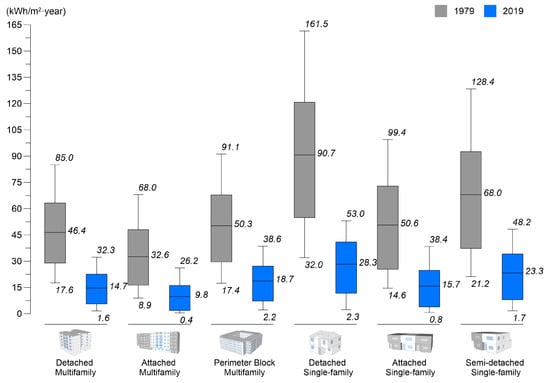
Figure 2.
Heating demand at reference set-point temperature for each building model and construction year in peninsular Spain.
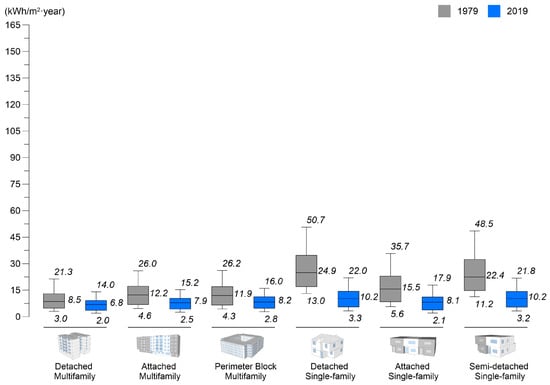
Figure 3.
Cooling demand at reference set-point temperature for each building model and construction year in peninsular Spain.
In Figure 2, we can observe with detail the expected heating demand range for the Spanish reference buildings, as well as the wide range of heating demand values of 1979 buildings compared with the latest buildings. This highlights the impact of improving the thermal envelope and the importance of incentivising building renovation, especially in a scenario where less than 2% [57] of the existing buildings were constructed under Directive 2010/31/EU, and 55% of Spanish buildings were built prior to the 1979 Building Technical Code [58].
Similarly, in Figure 3, one can observe the impact of improving the thermal envelope on the reduction of cooling demand. Yet, by comparing the heating and the cooling demand, it is possible to observe that the heating of a Spanish building is more energy-demanding, representing, on average, 70% of the total conditioning needs, an important consideration for a warm temperate climate.
Figure 4 presents a map of the average demand for heating and cooling per building typology and construction year for the reference set-point temperatures; locations with a C1, D1, or E1 climate were excluded from the data analysis of cooling demand because the moments in which the indoor temperature was above 25 °C occurred in 5% or less of the building occupation period during the cooling season. This figure demonstrates the validity of the developed methodology and suggests the possibility of replicating this study in other countries by adjusting the sample of reference buildings, the indoor reference conditions, and the climates or locations to suit the context of each country.
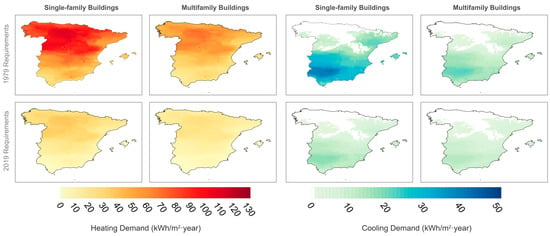
Figure 4.
Map of average heating (left) and cooling (right) demand by building typology and construction year.
The refinement of the Spanish building code is evident in Figure 4, where the heating or cooling demand had a slight variation across the peninsula, regardless of the building typology according to the 2019 code. Moreover, an impressive difference existed between the buildings built less than 20 years ago and the latest, especially when we compared the average heating demand of colder climate zones (upper part of the map) under the 1979 requirements with the new building code. Nonetheless, the demand reduction for heating and cooling demand in the southern zone (warm climates) was less expressive due to the fact of the new building code used a traditional approach of improving the thermal envelope by looking at the relevance of heating needs. This traditional approach represented a risk of conceiving buildings that were more suitable to overheating events [59]; notably, the number of buildings where the cooling needs represented most of the conditioning demand increased 4.9 times for multifamily buildings and 2.5 times for single-family buildings compared with the 1979 scenario. Passive cooling strategies should be introduced in the building code during the next review to guarantee the overall efficacy of the thermal envelope and to avoid counter-productive requirements [60,61,62].
3.2. Energy Savings
Figure 5 answers the question of how much energy is saved by extending the set-point temperature. This figure presents the average value of savings and the variation range, in kWh/m2/year, for each building typology and construction year. From the figure, it is highlighted that decreasing the set-point temperature by 1 °C during the winter season had more impact on the demand than increasing the set-point temperature by 1 °C during the summer season. At an average level and for single-family buildings, for example, 1.5 and 6.6 kWh/m2/year were the additional savings generated on the heating side, in comparison with the cooling savings for the 2019 and 1979 scenarios, respectively. Additionally, a higher savings potential in the oldest building stock was observed. Comparing the buildings of 1979 with the newest ones, we saw energy savings for heating demand of 2.8 to 2.9 times higher, and savings for cooling of 1.5 to 2.0 times higher, on average, indicating that the savings potential was lower on buildings that were adequately insulated.

Figure 5.
Annual demand savings for the studied set-point temperatures per building typology and construction year.
In a scenario where the average construction year for the residential building is 1978 [58] and 60.1% of the building stock corresponds to multifamily buildings [36], Figure 6 shows the expected impact of extending the set-point temperature by 1 °C and 2 °C in multifamily buildings across peninsular Spain. The highlighted set-point temperatures in the figure correspond to the set-point temperature values imposed by the Spanish Government on all public and commercial buildings as a strategy to reduce external energy dependency [63]. Transposing that restriction to the residential sector, we can obtain a saving on the heating demand from 4.6 kWh/m2∙year in warmer climates and up to 11.4 kWh/m2∙year in colder zones; on the side of the cooling demand, the savings can go up to 9.5 kWh/m2∙year in the southern part of the peninsula. The saving potential obtained is not negligible and does not compromise the thermal expectations of the majority of occupants when considering a minimum thermal acceptance of 80%. A variation of 1 to 2 °C in the neutral comfort band had a low impact on the occupant’s thermal acceptance, as demonstrated by Yung et al. [20] for the case of the summer season and by Daniel et al. [33] for the winter season in residential buildings in a mild climate. Moreover, considering the comfort band limits proposed by the ASHRAE adaptative model [34], it is possible to see that during the winter time, the comfort expectations were below 20 °C, as evidenced in the study by Bienvenido-Huertas et al. [31] for Mediterranean climates.
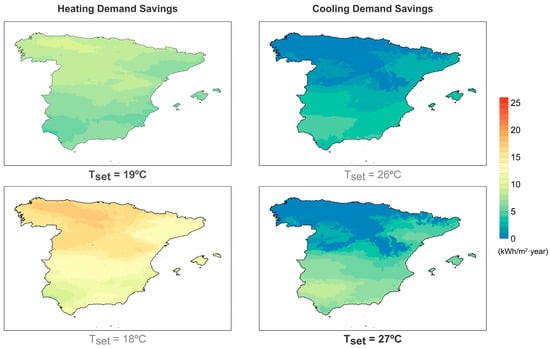
Figure 6.
Average heating (left) and cooling (right) demand savings for an extension of 1 °C (upper) and 2 °C (lower) of the set-point temperature in multifamily buildings of 1979.
Nevertheless, the effect of adopting a new set-point temperature is highly dependent on the climate as well as the building typology, as evidenced by Figure 5 and Figure 6; therefore, to corroborate the public authorities’ decisions in Appendix A, data on the average demand saving map for each building typology, construction year, and extension of the set-point temperature are available. It should be noted that with the energy-saving potential of lowering the heating set-point temperature, the risk of reducing the indoor environment quality can occur due to the increase in indoor humidity and the development of fungus [64]. Therefore, adopting new values for the heating set-point should consider the hygrometric behaviour of each building, where values below 18 °C must be avoided [44,64].
Evaluating the savings potential as a percentage (Figure 7), we have a slightly different overview, especially because the percentages of savings were very similar between the construction years and building typology. This similarity is more evident by analysis of the variation of the average savings percentage across peninsular Spain (Appendix B). The justification for that lies in the fact that the building models were exposed to the same outdoor and indoor conditions. However, Figure 7 shows that we can expect, on average, a demand reduction of 20% by lowering the heating set-point by 1 °C and a demand reduction of 25% by raising the cooling set-point by 1 °C. In addition, going to extreme set-point temperatures for heating or cooling, a huge reduction was obtained, and for some locations, that reduction could reach easily values above 90%.
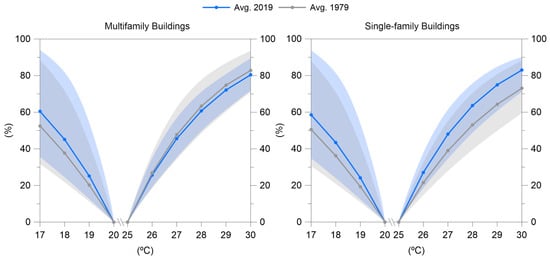
Figure 7.
Percentage of demand savings for the studied set-point temperatures per building typology and construction year.
The range of obtained values for the percentage of demand savings was comparable to the values mentioned by various authors in similar studies (Table 1). Yet, the results obtained for a set-point temperature extension of 1 °C exceeded largely the expectations of the International Energy Agency that pointed to a reduction of 7% and 10% in heating and cooling demand for the European building stock [4]. However, is not very clear how the International Energy Agency determined that savings potential by adjusting the thermostats of our homes.
4. Discussion
The results obtained from the research carried out allowed us to propose a series of practical implications. First, practical guidelines can be drawn as to the setpoints required to achieve a specific energy savings. The results pointed out that the same set-point temperature extension impacted differently on the demand savings potential due to the dependency on the climate and building envelope. Consequently, adjusting the set-point temperature to a building type and climate will ensure that each building will contribute equally to the implementation of the studied strategy. Although is not a novelty to define or adjust the set-point temperature to optimise the energy demand [19], the studies that explored the topic of extending the set-point temperature did not suggest or point to a recommended value to adopt for each building typology and climate zone (Table 1). Therefore, considering a savings target of 20% and 25% for heating and cooling demand, respectively, for example, it is possible to define a recommended value for residential buildings per climate zone (Table 7). The target corresponds to the average percentage savings potential by extending the set-point temperature to 1 °C (Section 3.2).

Table 7.
Set-point temperature value which reduces heating and cooling demand by at least 20% and 25%, respectively.
Table 7 was obtained by interpolating the savings curve of each building model for every location. Even so, the values per building typology presented a variation of less than 0.1 °C; thus, an average of the obtained values is presented per climate zone. From this table, it is possible to conclude that for peninsular Spain during the heating season, a set-point temperature of 19 °C should be required for all residential buildings in climate zones from A to C and 18 °C for the remaining climate zones. On the other hand, during the summer, 26 °C could be defined as the minimum set-point temperature for all climate zones, excluding the climate zones without cooling needs.
Furthermore, applying this work methodology to a country, regarding the climate conditions and its building stock, enables the precise determination of the energy impact resulting from a regulatory change in set-point temperature specifications. In this paper, Spain was analyzed as a unique case study due to its energy dependence and the crisis it is currently suffering. The savings potential of extending the set-point temperature was quantified for the Spanish reference buildings and was a value that was not negligable. It raises the question: What would be the expected savings for peninsular Spain? Table 8 provides an idea of the savings potential for Spain on thermal energy by setting 19 °C and 26 °C as the heating and cooling set-point temperatures, respectively. The presented values correspond to a weighted average, where it was considered that the building stock age had a uniform distribution across the peninsula, 2% of the existing buildings could be represented by the reference buildings for the 2019 building code [57], and the 1979 reference buildings could represent the remaining 98%. In addition, the floor area for each residential building type per climate zone was considered through the statistics for the existing floor area per building type [43,65] and following the methodology proposed by the Spanish Directorate for Architecture, Housing and Planning [36].

Table 8.
Potential energy savings by extending to 1 °C the heating and the cooling set-point temperature in Spain.
In a scenario where all Spanish residential buildings are conditioned, moving the conditioning system’s thermostat 1 °C could lead to a savings of up to 26.0 GWh/year in thermal energy for heating and 8.4 GWh/year for cooling at the peninsular level. Nevertheless, what can be learned by thermal energy and the magnitude of this strategy for Spain is difficult to explain to non-experts. To have an idea of what can be expected by introducing this strategy, which is highly promoted by the European Commission [2,4,66], to the Spanish residential sector, Figure 8 presents an estimation of the saved natural gas volume during the winter season and a comparison of the total natural gas demand for Spanish households and small and medium-sized enterprises (SMEs) in 2022 (52.3 TWh [67]).
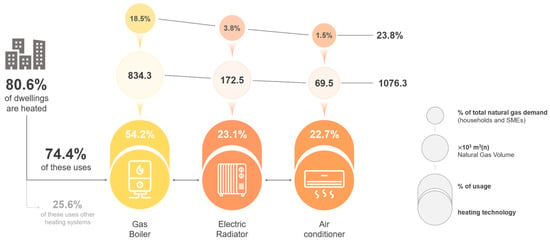
Figure 8.
Annual potential natural gas savings per heating technology for extending by 1 °C the heating set-point temperature in Spain. Savings expressed in a normal cubic meter and percentage of total natural gas demand for households and SMEs in 2022.
According to the latest survey of housing characteristics by the Spanish Statistical Office [41], only 80.6% of dwellings are equipped with a heating system, and 74.4% of these use a heating system based on natural gas or electricity, i.e., 60.0% of dwellings. In addition, 25.6% of the heated dwellings use oil, derivates, or other fuels (biomass, coal, etc.) and were excluded from the analysis of quantifying a fuel savings potential due to their irrelevance on the natural gas dependency. However, according to Building Technical Code Standard DB-HE0 [40], the Spanish dwellings are conditioned usually using three heating technologies, including a gas boiler (η = 0.92), an electric radiator (η = 1.00), and an air conditioner (split unit, COP = 2.90), where the usage percentage of these heating systems was extracted from the housing characteristics survey [41]. Considering the pointed value of gross savings of peninsular building stock in Table 8, it can be assumed that the gross savings will correspond proportionally to the floor area of dwellings with a heating system based on natural gas or electricity, i.e., 15.6 GWh/year on gross savings in heating demand based on electricity or natural gas. Therefore, the natural gas savings are given by defining a gas conversion factor for each energy vector, in the case of natural gas and the electricity generated by gas power plants (Table 9). The conversion factors were obtained considering the average gross calorific value (GVC) of natural gas in Spain for 2022 (11.6 kWh/m3(n) [67]), the weight of natural gas power plants in the peninsular power system in 2022 (60.6 TWh, i.e., 23.1% [68]), and the amount of natural gas used for electricity generation (138 TWh [67]).

Table 9.
Primary and natural gas normal volume conversion factors for natural gas and electricity based on natural gas in Spain for the year 2022 [67,68].
The objective of Figure 8 is to point out the expected impact of changing our homes’ thermostats by 1 °C, highlighting the 1076.3 thousand normal cubic meters of natural gas that could be saved. This value represents 23.8% of households and SMEs’ total natural gas demand in peninsular Spain in 2022. Hypothetically, if considering the same usage percentage of the typical heating systems and that all Spanish dwellings use one of them, the natural gas saving could reach up to 1.8 million normal cubic meters, representing almost 40% of the gas demand of households in 2022. However, quantifying this with an accurate number is difficult due to the diversity of heating systems, their efficiency, and the possibility of having more than one heating system in a dwelling. In addition, predicting the occupant’s behaviour is a difficult task, especially in dwellings where the decision to turn on the heating system relies on economic factors and the thermal comfort perceived by each occupant.
This overview does not consider the impact of the income rate of each household or the perceived thermal comfort of the occupants in each building and climate zone on the decision of conditioning or not conditioning the dwelling. The focus of this study is to assess the impact on energy demand by adopting new universal set-point temperatures, as opposed to the conventional neutral comfort band outlined in the regulation. However, the extension of the neutral comfort band should consider the thermal acceptance of the occupants as well as the possible impact on the indoor environment quality. Therefore, a thorough comfort assessment is necessary to determine the suitability of the suggested static set-point temperatures for each climate and building. As a future line of research, it would be valuable to explore the integration of occupant feedback and indoor environment quality for the definition of reference set-point temperatures by the building code.
5. Conclusions
Europe is currently facing an unprecedented energy crisis, similar to the oil crisis of the 1970s. To ensure energy market stability and reduce dependency on natural gas, the European Commission has encouraged the adoption of various strategies, including extending the thermostats of dwelling conditioning systems by 1 °C.
The results of this study indicated that implementing this strategy could lead to a significant reduction in gas demand for households in peninsular Spain, estimated at 1.8 million normal cubic meters, representing almost 40% of the total gas demand in 2022. On average, lowering the heating set-point by 1 °C could result in a 20% reduction in heating demand, while raising the cooling set-point by 1 °C could lead to a 25% reduction in cooling demand. The percentage of savings varied slightly across different construction years and building typologies. Furthermore, older building stock demonstrated a higher savings potential, with the ability to save up to 2.9 times more energy than adequately insulated buildings. These findings suggested that extending the neutral comfort band in residential buildings by 1 to 2 °C can be a promising strategy to achieve energy efficiency without compromising occupant thermal comfort.
Renovating the existing building stock has the potential to significantly reduce energy demand, with an average reduction of 72.1% for heating and 45.7% for cooling. These findings highlighted the importance of promoting the improvement of the thermal envelope of existing buildings, especially considering that 98% of existing buildings do not meet the requirements of the Energy Building Performance Directive (Directive 2010/31/EU).
The study’s analysis of map data revealed that adopting the same set-point temperature for all climates would result in different impacts on each building’s energy performance due to climate and thermal envelope dependencies. Therefore, when implementing this strategy, it is crucial to adjust the set-point temperature on the basis of building type and climate to ensure equitable contributions from each building. The study suggested a set-point temperature value that achieved at least a 20% reduction in heating and cooling demand for Spanish residential buildings.
This paper aimed to quantify the impact of adopting a new static thermal comfort band in Spanish homes while addressing the poor characterisation of the building stock, climate representation, and lack of uniformity in chosen set-point temperatures in existing studies. The energy demand and savings maps presented in Appendix A and Appendix B serve as valuable information for public authorities, especially in the formulation of guidelines for energy-saving programs and implementing restrictions during periods of energy scarcity.
While it is crucial to recognize the potential reduction in energy demand through this strategy, it is not reasonable to expose occupants in conditioned buildings to unfavourable conditions, particularly below 17 °C or above 29 °C. Informing and motivating occupants are essential factors for the successful adoption of new or temporary habits.
Considering the diverse range of buildings, their thermal envelopes, and climates across Europe, further studies should be conducted in other European countries to assess the overall impact of this strategy. The methodology developed in this study can be adapted to other countries by adjusting the sample of reference buildings, indoor reference conditions, and climates or locations to suit each country’s context.
Author Contributions
Conceptualization, S.Á.D. and M.d.C.G.D.; methodology, M.d.C.G.D. and R.M.P.; software, L.R.R.; validation, S.Á.D. and J.S.R.; formal analysis, R.M.P.; investigation, J.S.R. and R.M.P.; resources, S.Á.D. and T.R.P.A.; data curation, T.R.P.A.; writing—original draft preparation, R.M.P.; writing—review and editing, M.d.C.G.D.; visualisation, R.M.P. and L.R.R.; supervision, S.Á.D. and J.S.R.; project administration, J.S.R.; funding acquisition, J.S.R. All authors have read and agreed to the published version of the manuscript.
Funding
The Spanish Government funded this study under the project “Constancy—Resilient urbanisation methodologies and natural conditioning using imaginative nature-based solutions and cultural heritage to recover the street life” (Grant number: PID2020–118972RB-I00) funded by MCIN/AEI/10.13039/501100011033.
Institutional Review Board Statement
Not applicable.
Informed Consent Statement
Not applicable.
Data Availability Statement
Data is contained within the article.
Conflicts of Interest
The authors declare no conflict of interest.
Abbreviations
| ASHRAE | American Society of Heating, Refrigerating and Air-conditioning Engineers |
| HVAC | Heating, Ventilation, and Air Conditioning |
| GVC | Gross Calorific Value |
| COP | Coefficient of Performance |
| TMY | Typical meteorological years |
| IDF | Input data file |
| VBA | Visual Basic |
| η | Efficiency |
| g⊥ | Solar heat gain coefficient |
| U | Surface coefficient of heat transfer |
| ΔUφ | Transmittance increment due to thermal bridges |
| Coefficient of air permeability at 100 Pa | |
| n50 | Air–change rate at 50 Pa |
| Monthly mean outdoor temperature | |
| Running mean outdoor temperature | |
| Prevailing mean outdoor temperature | |
| Temperature increment |
Appendix A
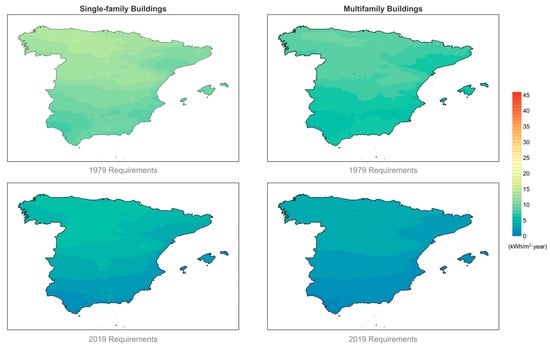
Figure A1.
Map of average savings on heating demand for a decrease of 1 °C on the set-point temperature per building typology and construction year.
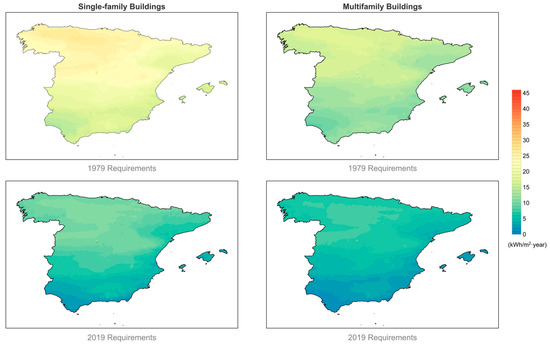
Figure A2.
Map of average savings on heating demand for a decrease of 2 °C on the set-point temperature per building typology and construction year.

Figure A3.
Map of average savings on heating demand for a decrease of 3 °C on the set-point temperature per building typology and construction year.
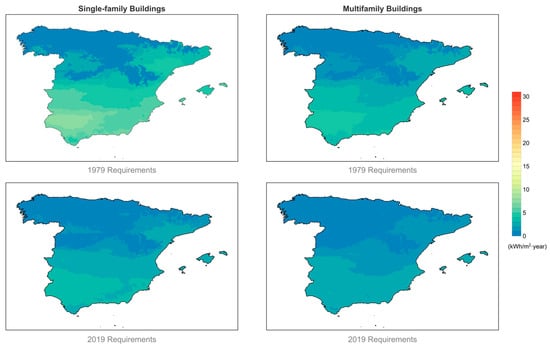
Figure A4.
Map of average savings on cooling demand for an increase of 1 °C on the set-point temperature per building typology and construction year.
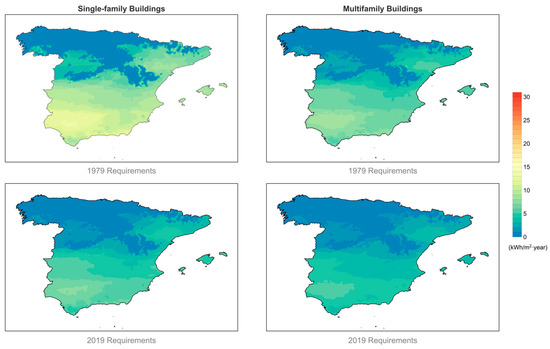
Figure A5.
Map of average savings on cooling demand for an increase of 2 °C on the set-point temperature per building typology and construction year.
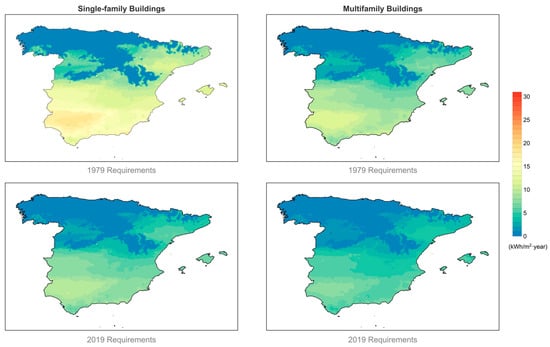
Figure A6.
Map of average savings on cooling demand for an increase of 3 °C on the set-point temperature per building typology and construction year.

Figure A7.
Map of average savings on cooling demand for an increase of 4 °C on the set-point temperature per building typology and construction year.
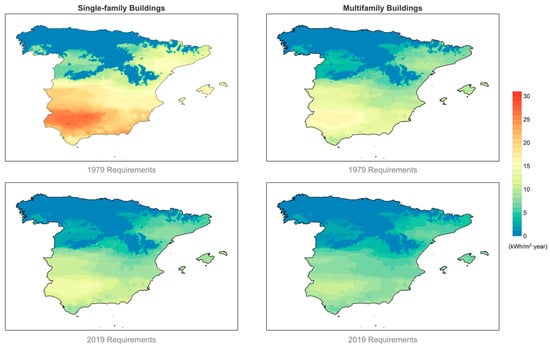
Figure A8.
Map of average savings on cooling demand for an increase of 5 °C on the set-point temperature per building typology and construction year.
Appendix B
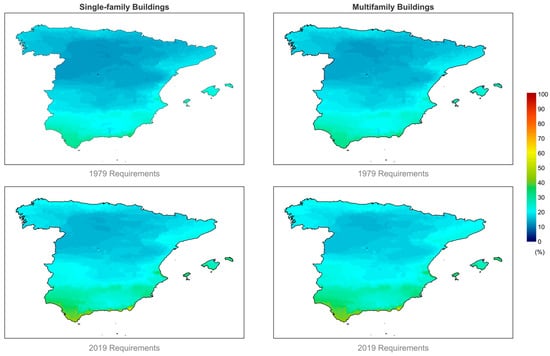
Figure A9.
Map of average savings percentage on heating demand for a decrease of 1 °C on the set-point temperature per building typology and construction year.
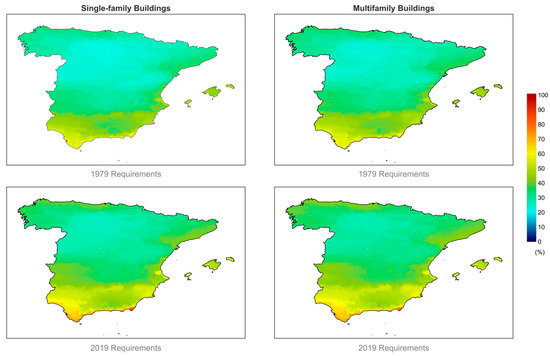
Figure A10.
Map of average savings percentage on heating demand for a decrease of 2 °C on the set-point temperature per building typology and construction year.
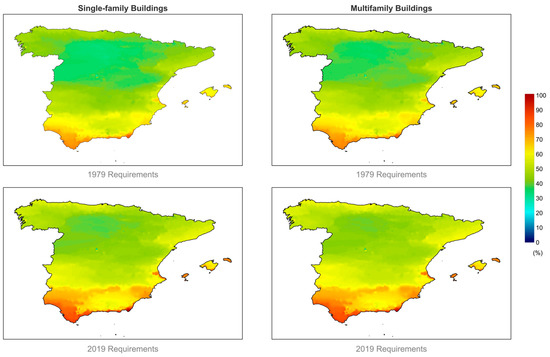
Figure A11.
Map of average savings percentage on heating demand for a decrease of 3 °C on the set-point temperature per building typology and construction year.
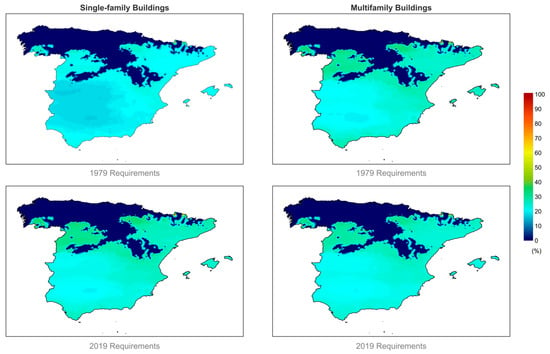
Figure A12.
Map of average savings percentage on cooling demand for an increase of 1 °C on the set-point temperature per building typology and construction year.
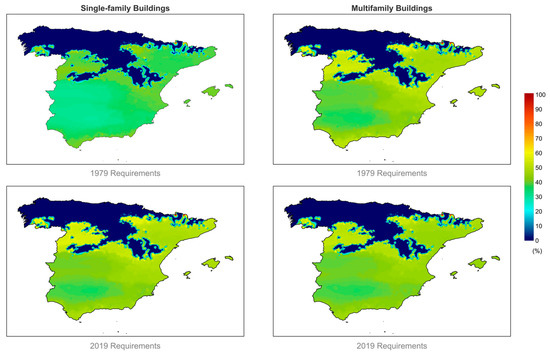
Figure A13.
Map of average savings percentage on cooling demand for an increase of 2 °C on the set-point temperature per building typology and construction year.
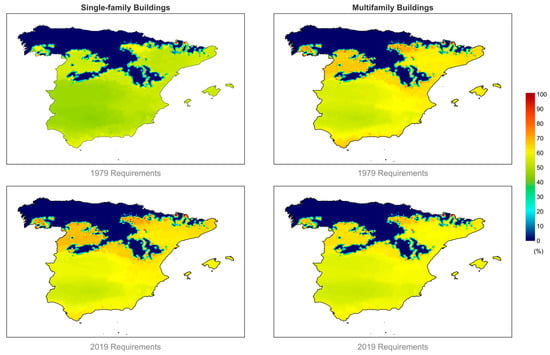
Figure A14.
Map of average savings percentage on cooling demand for an increase of 3 °C on the set-point temperature per building typology and construction year.
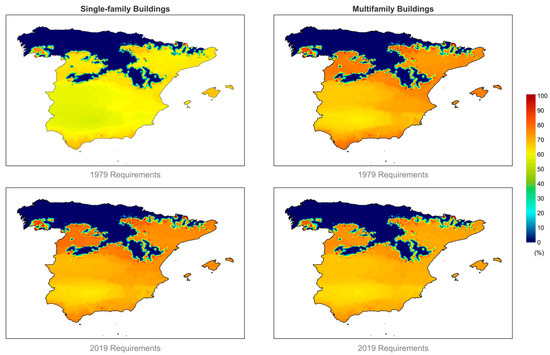
Figure A15.
Map of average savings percentage on cooling demand for an increase of 4 °C on the set-point temperature per building typology and construction year.
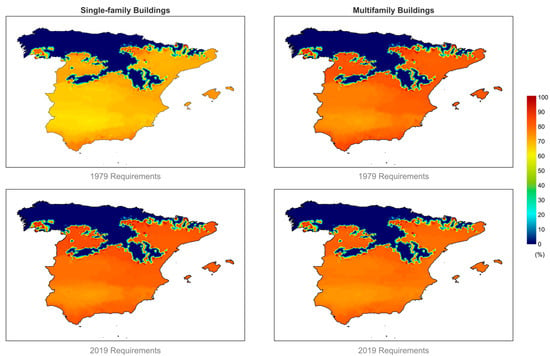
Figure A16.
Map of average savings percentage on cooling demand for an increase of 5 °C on the set-point temperature per building typology and construction year.
References
- European Commission Communication from the Commission to the European Parliament, the Council, the European Economic and Social Committee and the Committee of the Regions. Save Gas for a Safe Winter; COM(2022) 360 Final; European Commission: Brussels, Belgium, 2022. [Google Scholar]
- European Commission Communication from the Commission to the European Parliament, the Council, the European Economic and Social Committee and the Committee of the Regions. Save Gas for a Safe Winter: Annex; COM(2022) 360 Final: Annex; European Commission: Brussels, Belgium, 2022. [Google Scholar]
- Hanschke, H. Operator Data Suggests Nord Stream 1 Flows to Resume. Reuters, 3 September 2022. [Google Scholar]
- International Energy Agency; European Commission Playing My Part. How to Save Money, Reduce Reliance on Russian Energy, Support Ukraine and Help the Planet; IEA Publications: Paris, France, 2022. [Google Scholar]
- International Energy Agency. A 10-Point Plan to Reduce the European Union’s Reliance on Russian Natural Gas; IEA Publications: Paris, France, 2022. [Google Scholar]
- Rüdiger, M. The 1973 Oil Crisis and the Designing of a Danish Energy Policy. Hist. Soc. Res. Hist. Soz. 2014, 39, 94–112. [Google Scholar]
- Morton, R.C.B. The Nixon Administration Energy Policy. Ann. Am. Acad. Pol. Soc. Sci. 1973, 410, 65–74. [Google Scholar] [CrossRef]
- Nixon, R. Weekly Compilation of Presidential Documents. The Energy Emergency. Pres. Doc. 1973, 9, 1309–1328. [Google Scholar]
- United States President Jimmy Carter (1977–1981: Carter). Public Papers of the Presidents of the United States, Jimmy Carter; Office of the Federal Register, National Archives and Records Administration: Washington, DC, USA, 1980; Volume 1.
- Costa, F.J.M. Can Rationing Affect Long Run Behavior? Evidence from Brazil. SSRN Electron. J. 2013. [Google Scholar] [CrossRef]
- Murakoshi, C.; Hirayama, S.; Nakagami, N. Analysis of Behaviour Change Due to Electricity Crisis: Japanese Household Electricity Consumer Behaviour since the Earthquake. In Proceedings of the ECEEE Summer Study Proceedings, Foundations of Future Energy Policy, Hyères, France, 3–8 June 2013; pp. 29–39. [Google Scholar]
- Yamtraipat, N.; Khedari, J.; Hirunlabh, J.; Kunchornrat, J. Assessment of Thailand Indoor Set-Point Impact on Energy Consumption and Environment. Energy Policy 2006, 34, 765–770. [Google Scholar] [CrossRef]
- Moon, J.W.; Han, S.-H. Thermostat Strategies Impact on Energy Consumption in Residential Buildings. Energy Build. 2011, 43, 338–346. [Google Scholar] [CrossRef]
- Wan, K.K.W.; Li, D.H.W.; Lam, J.C. Assessment of Climate Change Impact on Building Energy Use and Mitigation Measures in Subtropical Climates. Energy 2011, 36, 1404–1414. [Google Scholar] [CrossRef]
- Spyropoulos, G.N.; Balaras, C.A. Energy Consumption and the Potential of Energy Savings in Hellenic Office Buildings Used as Bank Branches—A Case Study. Energy Build. 2011, 43, 770–778. [Google Scholar] [CrossRef]
- Lakeridou, M.; Ucci, M.; Marmot, A.; Ridley, I. The Potential of Increasing Cooling Set-Points in Air-Conditioned Offices in the UK. Appl. Energy 2012, 94, 338–348. [Google Scholar] [CrossRef]
- Fernandez, N.; Katipamula, S.; Wang, W.; Huang, Y.; Liu, G. Energy Savings Modelling of Re-Tuning Energy Conservation Measures in Large Office Buildings. J. Build. Perform. Simul. 2015, 8, 391–407. [Google Scholar] [CrossRef]
- Hoyt, T.; Arens, E.; Zhang, H. Extending Air Temperature Setpoints: Simulated Energy Savings and Design Considerations for New and Retrofit Buildings. Build. Environ. 2015, 88, 89–96. [Google Scholar] [CrossRef]
- Ghahramani, A.; Zhang, K.; Dutta, K.; Yang, Z.; Becerik-Gerber, B. Energy Savings from Temperature Setpoints and Deadband: Quantifying the Influence of Building and System Properties on Savings. Appl. Energy 2016, 165, 930–942. [Google Scholar] [CrossRef]
- Yun, G.Y.; Lee, J.H.; Steemers, K. Extending the Applicability of the Adaptive Comfort Model to the Control of Air-Conditioning Systems. Build. Environ. 2016, 105, 13–23. [Google Scholar] [CrossRef]
- Tushar, W.; Wang, T.; Lan, L.; Xu, Y.; Withanage, C.; Yuen, C.; Wood, K.L. Policy Design for Controlling Set-Point Temperature of ACs in Shared Spaces of Buildings. Energy Build. 2017, 134, 105–114. [Google Scholar] [CrossRef]
- American Society of Heating, Refrigerating, and Air-Conditioning Engineers (ASHRAE). Standard 55-2013; Thermal Environmental Conditions for Human Occupancy. American Society of Heating, Refrigerating, and Air-Conditioning Engineers, Inc.: Atlanta, GA, USA, 2013.
- Sánchez-Guevara Sánchez, C.; Mavrogianni, A.; Neila González, F.J. On the Minimal Thermal Habitability Conditions in Low Income Dwellings in Spain for a New Definition of Fuel Poverty. Build. Environ. 2017, 114, 344–356. [Google Scholar] [CrossRef]
- Aghniaey, S.; Lawrence, T.M. The Impact of Increased Cooling Setpoint Temperature during Demand Response Events on Occupant Thermal Comfort in Commercial Buildings: A Review. Energy Build. 2018, 173, 19–27. [Google Scholar] [CrossRef]
- European Committee for Standardization. EN 15251; Indoor Environmental Input Parameters for Design and Assessment of Energy Performance of Buildings—Addressing Indoor Air Quality, Thermal Environment, Lighting and Acoustics. European Committee for Standardization: Brussels, Belgium, 2007; Volume 3, pp. 1–52.
- Sánchez-García, D.; Bienvenido-Huertas, D.; Tristancho-Carvajal, M.; Rubio-Bellido, C. Adaptive Comfort Control Implemented Model (ACCIM) for Energy Consumption Predictions in Dwellings under Current and Future Climate Conditions: A Case Study Located in Spain. Energies 2019, 12, 1498. [Google Scholar] [CrossRef]
- Wang, C.; Pattawi, K.; Lee, H. Energy Saving Impact of Occupancy-Driven Thermostat for Residential Buildings. Energy Build. 2020, 211, 109791. [Google Scholar] [CrossRef]
- Sunardi, C.; Hikmat, Y.P.; Margana, A.S.; Sumeru, K.; Sukri, M.F.B. Effect of Room Temperature Set Points on Energy Consumption in a Residential Air Conditioning. AIP Conf. Proc. 2020, 2248, 70001. [Google Scholar]
- Bienvenido-Huertas, D.; Sánchez-García, D.; Pérez-Fargallo, A.; Rubio-Bellido, C. Optimization of Energy Saving with Adaptive Setpoint Temperatures by Calculating the Prevailing Mean Outdoor Air Temperature. Build. Environ. 2020, 170, 106612. [Google Scholar] [CrossRef]
- European Committee for Standardization. EN 16798-1: 2019; Energy Performance of Buildings—Ventilation for Buildings—Part 1: Indoor Environmental Input Parameters for Design and Assessment of Energy Performance of Buildings Addressing Indoor Air Quality. Thermal Environment, Lighting and Acoustics. European Committee for Standardization: Brussels, Belgium, 2019.
- Bienvenido-Huertas, D.; Sánchez-García, D.; Rubio-Bellido, C.; Pulido-Arcas, J.A. Influence of the Improvement in Thermal Expectation Levels with Adaptive Setpoint Temperatures on Energy Consumption. Appl. Sci. 2020, 10, 5282. [Google Scholar] [CrossRef]
- Bienvenido-Huertas, D. Influence of the Type of Thermostat on the Energy Saving Obtained with Adaptive Setpoint Temperatures: Analysis in the Current and Future Scenario. Energy Build. 2021, 244, 111024. [Google Scholar] [CrossRef]
- Daniel, L.; Baker, E.; Williamson, T. Cold Housing in Mild-Climate Countries: A Study of Indoor Environmental Quality and Comfort Preferences in Homes, Adelaide, Australia. Build. Environ. 2019, 151, 207–218. [Google Scholar] [CrossRef]
- American Society of Heating, Refrigerating, and Air-Conditioning Engineers (ASHRAE). Standard 55-2020; Thermal Environmental Conditions for Human Occupancy. American Society of Heating, Refrigerating, and Air-Conditioning Engineers, Inc.: Atlanta, GA, USA, 2020.
- Directorate-General for Energy EU Buildings Database. Available online: https://ec.europa.eu/energy/eu-buildings-database_en (accessed on 3 October 2022).
- Directorate for Architecture, Housing and Planning—Ministry of Development of Spain. Report on Cost Optimal Calculations and Comparison with the Current and Future Energy Performance Requirements of Buildings in Spain; Ministry of Development of Spain: Madrid, Spain, 2018. [Google Scholar]
- Directorate for Architecture, Housing and Planning—Ministry of Development of Spain. Report on Cost Optimal Calculations and Comparison with the Current and Future Energy Performance Requirements of Buildings in Spain; Ministry of Development of Spain: Madrid, Spain, 2013. [Google Scholar]
- Presidencia del Gobierno Real Decreto 2429/1979, de 6 de Julio, Por El Que Se Aprueba La Norma Básica de Edificación NBE-CT-79, Sobre Condiciones Térmicas En Los Edificios. Boletín Oficial Estado 1979, 253, 24524–24550.
- Ministerio de Fomento Real Decreto 732/2019, de 20 de Diciembre, Por El Que Se Modifica El Código Técnico de La Edificación, Aprobado Por El Real Decreto 314/2006, de 17 de Marzo. Boletín Oficial Estado 2019, 311, 140488–140674.
- Dirección General de Arquitectura, Vivienda y Suelo DB-HE0. Limitación Del Consumo Energético. DB-HE0. 2022. Available online: https://www.codigotecnico.org/pdf/Documentos/HE/DcmHE.pdf (accessed on 13 May 2023).
- Instituto Nacional de Estadística. Survey of Essential Population and Housing Characteristics 2021 (ECEPOV), Year 2021. Definitive Data. Press Releases 2023. Available online: https://www.ine.es/en/prensa/ecepov_2021_en.pdf (accessed on 13 May 2023).
- Ahmed, K.; Akhondzada, A.; Kurnitski, J.; Olesen, B. Occupancy Schedules for Energy Simulation in New PrEN16798-1 and ISO/FDIS 17772-1 Standards. Sustain. Cities Soc. 2017, 35, 134–144. [Google Scholar] [CrossRef]
- Instituto Nacional de Estadística. Continuous Household Survey, Year 2020. Press Releases 2021. Available online: https://www.ine.es/en/prensa/ech_2020_en.pdf (accessed on 13 May 2023).
- ASHRAE. 2017 ASHRAE® Handbook—Fundamentals (SI Edition); American Society of Heating Refrigerating and Air-Conditioning Engineers Inc.: Atlanta, GA, USA, 2017; ISBN 1-5231-1351-0. [Google Scholar]
- USP 41–NF 36 Standard; The United States Pharmacopeial Convention <659> Packaging and Storage Requirements. Revision Bulletin, Postponement. The United States Pharmacopeial Convention: North Bethesda, MD, USA, 2017.
- André, M.; Bandurski, K.; Bandyopadhyay, A.; Bavaresco, M.; Buonocore, C.; de Castro, L.; Hahn, J.; Kane, M.; Lingua, C.; Pioppi, B.; et al. Practical Differences in Operating Buildings across Countries and Climate Zones: Perspectives of Building Managers/Operators. Energy Build. 2023, 278, 112650. [Google Scholar] [CrossRef]
- Beck, H.E.; Zimmermann, N.E.; McVicar, T.R.; Vergopolan, N.; Berg, A.; Wood, E.F. Present and Future Köppen-Geiger Climate Classification Maps at 1-Km Resolution. Sci. Data 2018, 5, 180214. [Google Scholar] [CrossRef] [PubMed]
- Chazarra Bernabé, A.; Lorenzo Mariño, B.; Romero Fresneda, R.; Moreno García, J.V. Evolución de Los Climas de Köppen En España En El Periodo 1951-2020; Agencia Estatal de Metereología: Madrid, Spain, 2022. [Google Scholar]
- Dirección General de Arquitectura, Vivienda y Suelo. DB-HE0. Documento Descriptivo Climas de Referencia. DB-HE0 2017. Available online: https://www.codigotecnico.org/pdf/Documentos/HE/20170202-DOC-DB-HE-0-Climas%20de%20referencia.pdf (accessed on 13 May 2023).
- Salmerón, J.M.; Álvarez, S.; Molina, J.L.; Ruiz, A.; Sánchez, F.J. Tightening the Energy Consumptions of Buildings Depending on Their Typology and on Climate Severity Indexes. Energy Build 2013, 58, 372–377. [Google Scholar] [CrossRef]
- Lawrie, L.K.; Crawley, D.B. Development of Global Typical Meteorological Years (TMYx). Available online: http://climate.onebuilding.org (accessed on 14 December 2022).
- Joint Research Centre. European Commission. PVGIS Photovoltaic Geographical Information System. Available online: https://re.jrc.ec.europa.eu/pvg_tools/en/ (accessed on 14 December 2022).
- Thomsen, K.E.; Wittchen, K.B. Energy Performance Requirements Using the Cost-Optimal Methodology. Overview and Outcomes. In Implementing the Energy Performance of Buildings Directive (EPBD); Portuguese Energy Agency (ADENE): Lisboa, Portugal, 2013; pp. 37–46. [Google Scholar]
- Pérez-Lombard, L.; Ortiz, J.; Coronel, J.F.; Maestre, I.R. A Review of HVAC Systems Requirements in Building Energy Regulations. Energy Build. 2011, 43, 255–268. [Google Scholar] [CrossRef]
- Dirección General de Arquitectura, Vivienda y Suelo. DA DB-HE/3. Puentes Térmicos. Código Técnico de la Edificación; Dirección General de Arquitectura, Vivienda y Suelo: Madrid, Spain, 2019. [Google Scholar]
- International Standards Organization. EN ISO 14683:2020; Thermal Bridges in Building Construction—Linear Thermal Transmittance—Simplified Methods and Default Values. ISO: Geneva, Switzerland, 2020.
- Ministerio de Transportes, Movilidad y Agenda Urbana. Boletín Estadístico de Estimación del Parque de Viviendas. Estadísticas Online, 1 October 2023. [Google Scholar]
- Filippidou, F.; Jimenez Navarro, J. Achieving the Cost-Effective Energy Transformation of Europe’s Buildings: Combinations of Insulation and Heating & Cooling Technologies Renovations: Methods and Data; Publications Office of EU: Luxembourg, 2019. [Google Scholar] [CrossRef]
- Shrubsole, C.; Macmillan, A.; Davies, M.; May, N. 100 Unintended Consequences of Policies to Improve the Energy Efficiency of the UK Housing Stock. Indoor Built Environ. 2014, 23, 340–352. [Google Scholar] [CrossRef]
- Zero Carbon Hub. Solutions to Overheating in Homes: Evidence Review; Zero Carbon Hub: London, UK, 2016. [Google Scholar]
- Psomas, T.; Heiselberg, P.; Duer, K.; Bjørn, E. Overheating Risk Barriers to Energy Renovations of Single Family Houses: Multicriteria Analysis and Assessment. Energy Build 2016, 117, 138–148. [Google Scholar] [CrossRef]
- Gupta, R.; Gregg, M.; Williams, K. Cooling the UK Housing Stock Post-2050s. Build. Serv. Eng. Res. Technol. 2015, 36, 196–220. [Google Scholar] [CrossRef]
- Jefatura del Estado Real Decreto 14/2022, de 1 de Agosto, de Medidas de Sostenibilidad Económica En El Ámbito Del Transporte, En Materia de Becas y Ayudas al Estudio, Así Como de Medidas de Ahorro, Eficiencia Energética y de Reducción de La Dependencia Energética Del Gas Natural. Boletín Oficial Estado 2022, 184, 111381–111463.
- ASHRAE. ASHRAE Guideline 29-2019. Guideline for the Risk Management of Public Health and Safety in Buildings; American Society of Heating, Refrigerating, and Air-Conditioning Engineers, Inc.: Atlanta, GA, USA, 2019. [Google Scholar]
- Instituto Nacional de Estadística Censos de Población y Viviendas. Censos 2011. 2012. Available online: https://www.ine.es/censos2011_datos/cen11_datos_inicio.htm (accessed on 15 January 2023).
- European Commission; International Energy Agency (IEA). The European Commission and the IEA Outline Key Energy Saving Actions. Available online: https://ec.europa.eu/info/news/european-commission-and-iea-outline-key-energy-saving-actions-2022-apr-21_en (accessed on 20 September 2022).
- Enagás Monthly Gas Report December 2022; Madrid, 2022. Available online: https://www.enagas.es/content/dam/enagas/en/files/gestion-tecnica-del-sistema/energy-data/publicaciones/demanda-de-gas/demanda-mensual/Progreso_diciembre22.pdf (accessed on 3 March 2023).
- Red Eléctrica Electrical Energy Balance. Available online: https://www.ree.es/es/datos/balance/balance-electrico?start_date=2022-01-01T00:00&end_date=2022-12-31T23:59&time_trunc=year&systemElectric=peninsular (accessed on 2 March 2023).
Disclaimer/Publisher’s Note: The statements, opinions and data contained in all publications are solely those of the individual author(s) and contributor(s) and not of MDPI and/or the editor(s). MDPI and/or the editor(s) disclaim responsibility for any injury to people or property resulting from any ideas, methods, instructions or products referred to in the content. |
© 2023 by the authors. Licensee MDPI, Basel, Switzerland. This article is an open access article distributed under the terms and conditions of the Creative Commons Attribution (CC BY) license (https://creativecommons.org/licenses/by/4.0/).





